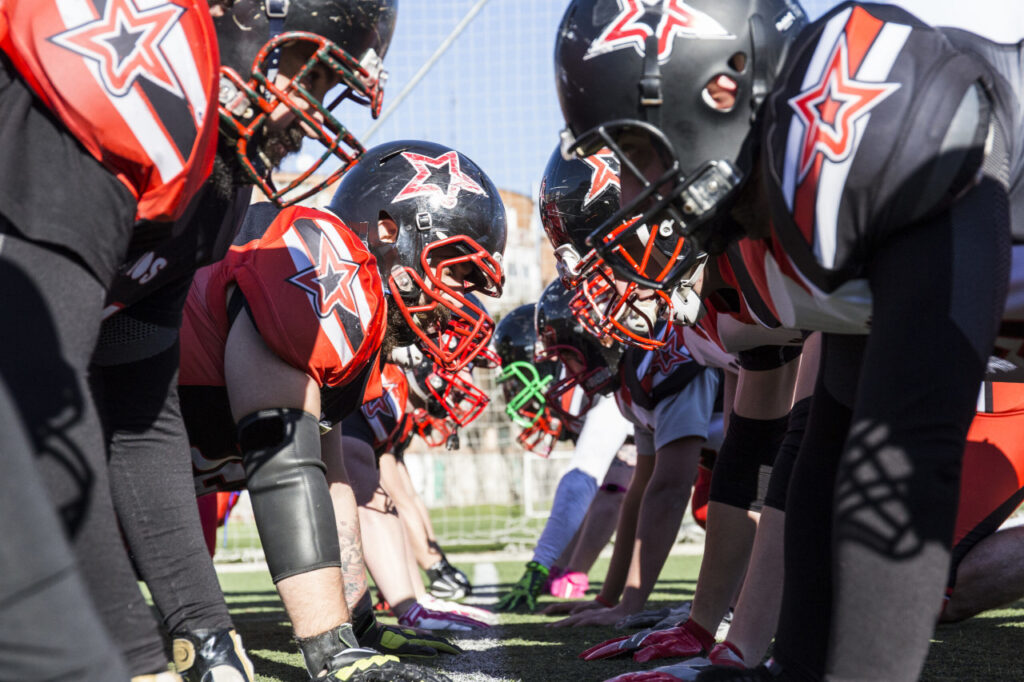Dieser Beitrag ist auch verfügbar auf:
Deutsch
The Super Bowl, the final game of the National Football League (NFL), is one of the biggest sporting events in the world. During the halftime break, world-famous music stars put on lavish performances that are not only a treat for American football fans.
The Super Bowl game of the American Football Professional League is a spectacle that breaks records year after year. But this type of contact sport with its million-dollar season finale also has a dark side, especially for its professional players: the risk of injury is extremely high.
NFL injuries in facts and figures
- On average, players sustain 65 injuries per 1000 appearances (as of 2012).
- In addition to knee, ankle and groin injuries, shoulder and foot problems as well as concussions are the top 6 of the most common injuries.
- Only 35 percent of reported concussions lead to player absence.
- Injuries resulting in death, due to e.g. broken necks, occur regularly.
On average, each game lasts about three hours, but the actual time the ball is actually moved is only eleven minutes. Despite this short time, the physicality of the sport is fraught with risk. Injuries not only have a significant impact on the current season. The long-term consequences, too, should not be underestimated.
Concussions lead to injuries with serious long-term consequences
No other sport records more brain injuries than American football. For decades, the NFL swept the problem under the rug and convinced a skeptical public that blows to the head were harmless to health.
A study published in 2007 conducted at the Center for the Study of Retired Athletes at the University of North Carolina on 2,552 former NFL players, however, found a clear link between the number of concussions and the rate of diagnosed depression. Of 595 former NFL players who had three or more concussions during their active careers, 20.2 percent suffered from this dangerous mental illness. Furthermore, in contrast to other men of the same age, those examined were found to have a 37 percent higher risk of developing Alzheimer’s disease.
The Nigerian neuropathologist Bennet Omalu wrote a scientific report back in 2005 in which he dubbed this phenomenon chronic traumatic encephalopathy, or CTE. In 1928, the pathologist Harrison Martland first mentioned the disease in connection with prize fighters.
The most common symptoms of CTE
A study published by the NY Times concluded that players should be removed from the field immediately after a concussion. Athletes who continued to play immediately after a concussion took twice as long to recover than those who took an immediate break. When athletes suffer from the late effects of a brain injury, the most common symptoms of CTE are as follows:
- Memory loss
- Behavioral and personality changes
- Parkinson’s disease
- Speech disorders
- Slowed gait
- Depression
- Suicide risk
- Aggressiveness
- Dementia
CTE cannot yet be clearly diagnosed clinically during the lifetime of the affected person, even when symptoms occur. A reliable diagnosis is only possible by processing the brain tissue after death.
In addition, mental health is still a stigmatized, taboo subject in our society. It is often difficult for individuals to recognize the symptoms of CTE and seek help. The clinical condition is not easily identified by clear, tangible signs, as is the case with e.g. a broken bone. Even when the symptoms can be clearly identified as CTE, the condition remains incurable.
Only supportive measures that also help with other forms of dementia or depression can be introduced. The condition affects not only professional athletes, but also soldiers, war refugees with blast trauma, and victims of domestic violence.
Criminal cases and suicides involving CTE
Junior Seau
The professional player Junior Seau was found dead in his apartment in May 2012. Investigations revealed that Seau took his own life by overdosing on prescription drugs. Posthumous examinations of the professional athlete, who played for the Miami Dolphins and the New England Patriots, among others, revealed a clear clinical picture: he suffered from CTE as a result of numerous brain injuries.
Aaron Hernandez
Aaron Hernandez played the position of tight end for the New England Patriots for three years. In 2013, the professional athlete was arrested on suspicion of murder and in April 2015, he was sentenced to life in prison without the possibility of early release. In 2017, the then 27-year-old took his own life. A few months later, it was announced that Hernandez was suffering from CTE and his brain already had stage three characteristics, an exceptionally advanced stage for his age.
Anthony McClanahan
Anthony McClanahan was part of the Canadian Football League and made headlines in 2017 when he was convicted of the murder of his wife Keri. The two had a physical altercation in which McClanahan stabbed his wife several times with a knife. As the ex-professional athlete is still alive, the diagnosis of CTE has not yet been finally confirmed.
Phillip Adams
Phillip Adams, who was born in 1988 and played for the New England Patriots, Seattle Seahawks and Atlanta Falcons, among others, killed six people in April 2021 and committed suicide the next day. Adams had no criminal record, and his father speculated in interviews that the sport had driven him insane. A subsequent autopsy confirmed the suspicion: Adam’s brain suffered from a particularly severe case of CTE.
Of course, crimes or suicides cannot be justified by CTE alone. The condition could only be an answer to the question of how the players’ bodies could be pushed so far.
The future of the NFL needs adjusted rules, special research funding and compensation payments
Adjusted NFL football rules
In an effort to reduce the number of head injuries, the NFL implemented a rule change in the 2013-14 season by a 31-1 vote of club owners. Since then, both offensive and defensive players have been prohibited from lowering their heads and hitting an opponent with their helmets.
These “spear tackles” result in a 15-yard penalty, which means that the offending team must start the next play from further back. To protect the players, there is also a concussion protocol: specially appointed game observers intervene in the event of suspected head injuries. The player must take a break, be examined immediately and may only return to the field after a professional examination. The league has also limited the number of full-contact practices.
Research funding to diagnose CTE before death
In December 2015, the National Institutes of Health provided the University of Arizona, the Banner Alzheimer’s Institute, Boston University, Brigham and Women’s Hospital and the Cleveland Clinic, among others, with a total of 16 million US dollars. The main purpose of the budget is to be able to diagnose CTE before death. The NFL initially made no financial contribution.
In September 2016, the NFL unveiled a 100 million US dollar package in response to growing criticism of the handling of head injuries. 60 million US dollars are to be invested in technological development, such as new helmets, and 40 million US dollars in the promotion of medical research into head injuries. Among other things, the money was to be used to investigate the long-term effects of concussions and to find measures to improve the health of long-term players.
Compensation payments for former players with CTE
In August 2013, the NFL agreed to pay out 765 million US dollars over 17 years to 18,000 former players as compensation for brain injuries caused by concussions. For the term of the contract, this resulted in less than 1.5 million US dollars per year for each of the 32 NFL clubs. A top player earned ten times as much per season in 2013. In January 2014, Judge Anita B. Brody of the United States District Court for the Eastern District of Pennsylvania rejected the USD 765 million settlement and demanded improvements.
The final settlement amount was one billion US dollars. The NFL estimates that approximately 6,000 former players will receive payments, each averaging $190,000. The settlement was unanimously deemed fair in April 2016 under the direction of Judge Anita Brody, which means that up to five million US dollars can be paid out per former player who has Alzheimer’s disease, amyotrophic lateral sclerosis (ALS), Parkinson’s disease, severe dementia, or CTE prior to 2015.
More than 8,000 NFL players were already registered for compensation payments at that time, although the process had not even started. The deal with the NFL does not help professional players who fall ill in the future: they now play at their own risk.






